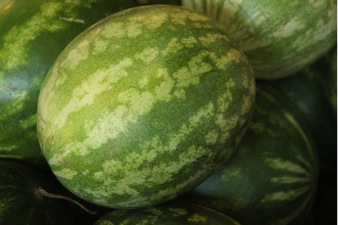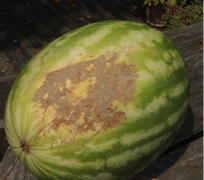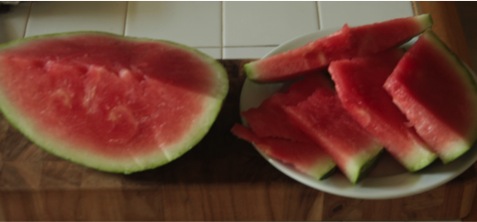
- Transplanting, Starting Seeds, Soil Preparation, Culture and Fertilization
- Harvesting
- Storage and Use
- Problems
- Varieties
Watermelon is a warm-season vegetable in the cucurbiteae family. It requires a lot of space, sunshine, water and nutrients. The long, hot Georgia summer is perfect for growing this mouth-watering, refreshing, sweet and tasty fruit. If you have extra room in the garden, watermelons can be fun and interesting to grow.
Transplanting, Starting Seeds, Soil Preparation, Culture and Fertilization
Transplants
Watermelons can be grown either by direct seeding or by using transplants. For transplants, start the seeds indoors about 4 or 5 weeks before the last frost. In south Georgia, that means starting them about the end of February. In north Georgia, this will be the end of March to the beginning of April. Plant one to two seeds per pot. Cover the seeds with the soil or potting mix, and keep them in a warm place with good light. Indoors, supplemental light may be required to promote sturdy growth and prevent plants from becoming leggy. Set up lights 6 to 12 in. above the plants, and keep them on for about 14 hr a day. Be sure to keep the soil and plants moist using a fine mist. Harden the plants off before transplanting them into the garden. This can be done by leaving them outside for 2 or 3 days, but bringing them back inside each night. On the fourth day, leave them outside for 24 hr.
Watermelons thrive in warm soils, so wait to transplant them until the danger of frost has passed and days are consistently sunny and warm. The soil temperature should reach 65–70°F before planting watermelon in the garden. Watermelons need a well-drained soil that receives 8 to 10 hr of sunlight per day.
Starting Seeds
Plant watermelon from seed in small hills with a spacing of 8 ft on all sides. Sow four to five seeds per hill at a depth of 1 in. A week after they have germinated, thin the seedlings to two per hill.
Soil Preparation
For proper fertilization, a soil test (available through your local county Extension office) is always recommended. The soil pH should be between 6.0 and 7.0 for best growth. In the absence of a soil test, a complete fertilizer such as 10-10-10 or 13-13-13 can be applied at the rate of 3 lb per 100 sq ft of garden. Spade or till the soil to a depth of at least 6 to 8 in. Adding organic matter in the form of topsoil, compost or a bagged amendment and incorporating into the native soil can help improve soil quality. After amending and tilling, level the soil with a rake.

Mulch the plants with weed-free grass clippings (already dried, not green), straw or wood chips to prevent weeds from growing and to conserve water. Water them as needed, to a depth of 6 in., preferably with drip irrigation. Overhead watering will soak the foliage and make it a lot more susceptible to pests and diseases, especially mildew. Depending on the type of soil, you may need to irrigate several times a week to provide adequate moisture. Overwatering should be avoided because it leaches nutrients from the soil and also makes plants more prone to disease.
Harvesting
Watermelon can be harvested anytime between 70 and 90 days depending on the variety. Look for a curly tendril at the stem. The watermelon is ready to be picked when the tendril opposite the fruit stem is completely dry. Other signs of ripeness include yellowing of the underside of the fruit and a dull thump sound when tapping the fruit.
Storage and Use

Problems
Insect and disease problems will differ from year to year depending on the environmental conditions and time of year the seeds or transplants are planted. Generally, later planted crops will have more problems with insects. Caterpillars such as rind worms, pickle worms and cutworms may be particularly troublesome during the latter part of the season. Aphids will often occur in clusters, particularly on new growth. During dry weather, mites and thrips are more likely to cause damage. It is important to scout the crop regularly for insect problems. Dealing with such problems early will reduce the damage.
Diseases can thrive in wet and humid weather. Directly sown seed is prone to dampening off if it is sown when the soil is cool. During periods of extended rain, foliar diseases are more likely to occur. There are several foliar diseases of watermelon, including gummy stem blight, downy mildew and anthracnose. Another foliar disease that is more likely to occur is powdery mildew. Soil-borne diseases, such as Fusarium wilt and root-knot nematodes, can also be problematic. Fusarium wilt can be difficult to predict from one year to the next, but in general, soils with a history of the disease should be avoided. Root-knot nematodes can be effectively controlled with crop rotations and non-host species.
Occasionally, deer or coyotes can damage the fruit. These pests should be kept away with repellents or fencing. It is important to always read any pesticide label before use. Use the product strictly according to the label directions. It is particularly important to follow all safety precautions.

Status and Revision History
Published on Dec 16, 2013
Published with Full Review on Sep 07, 2016
Published with Full Review on Jul 13, 2022


























































